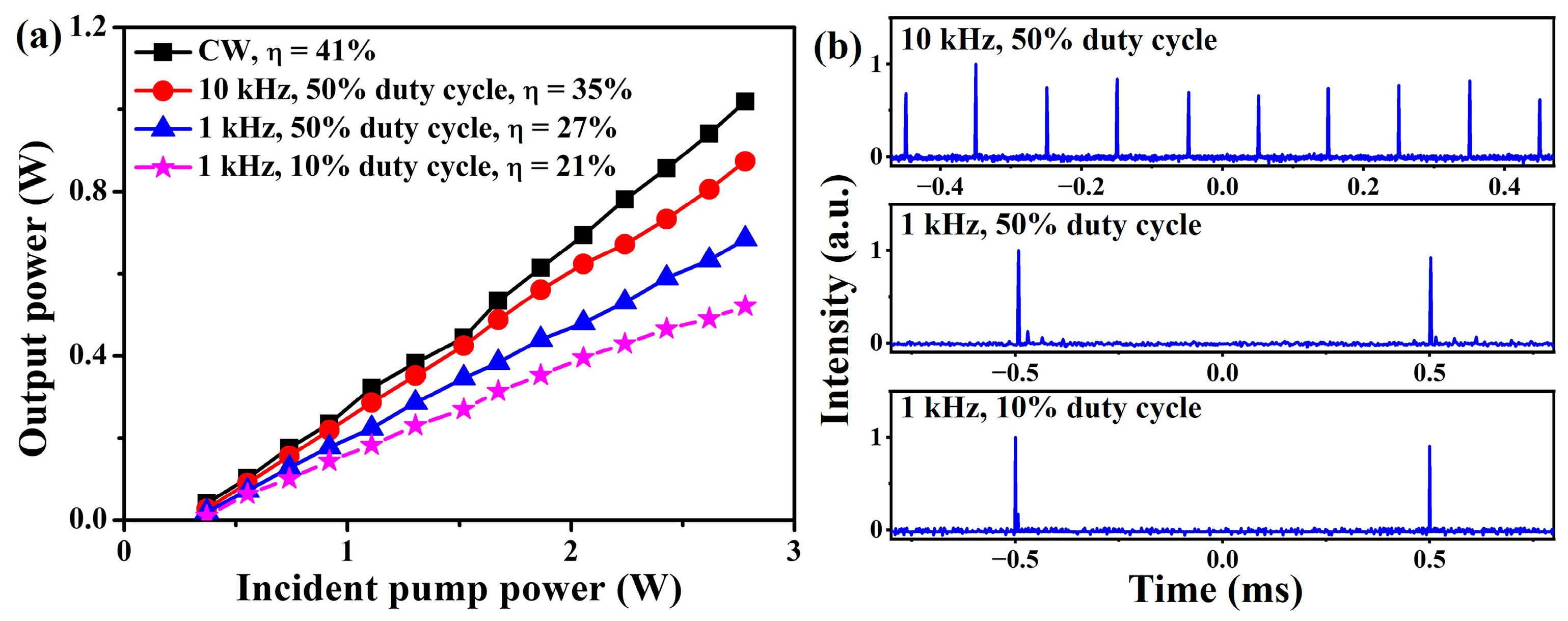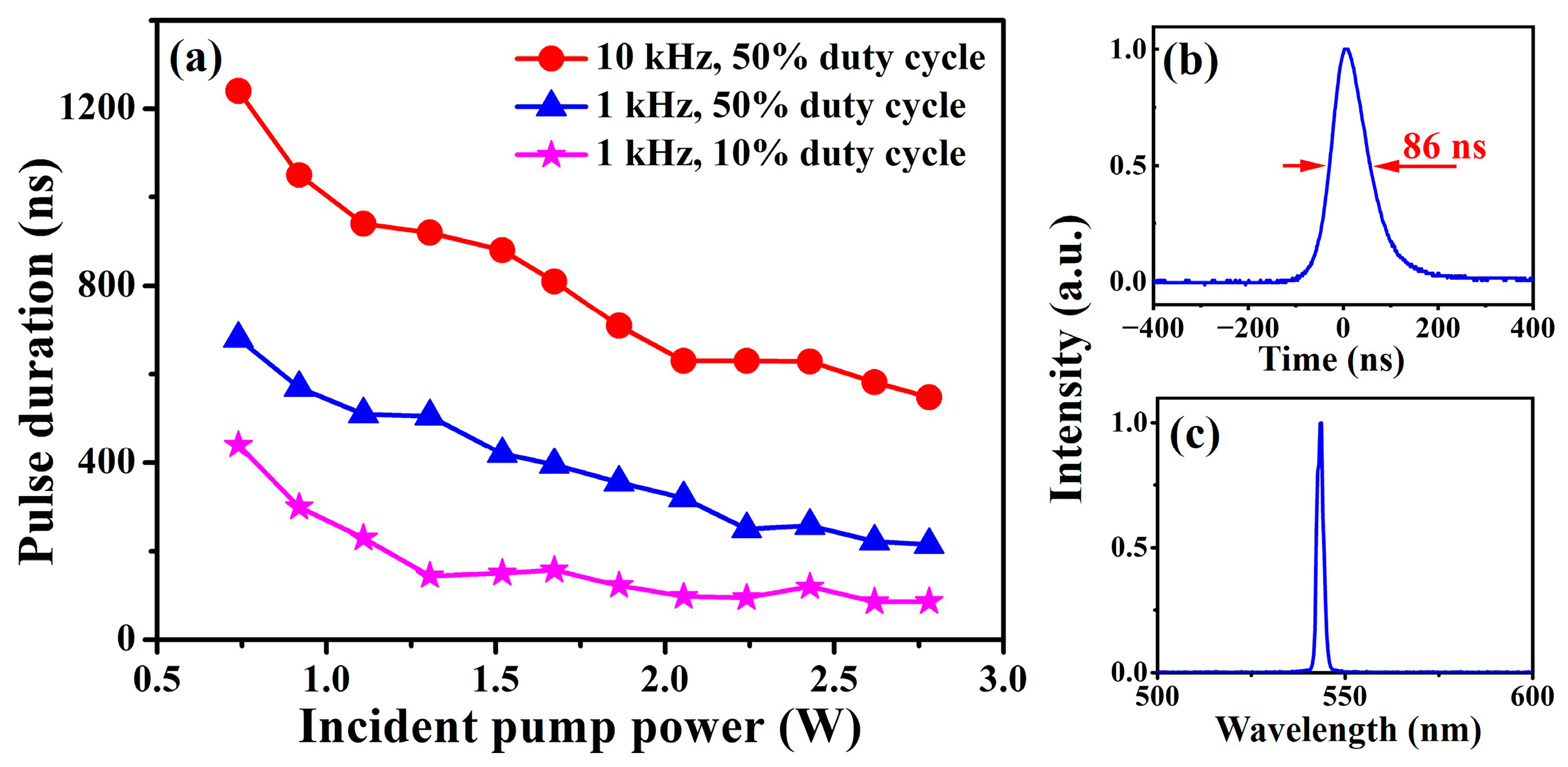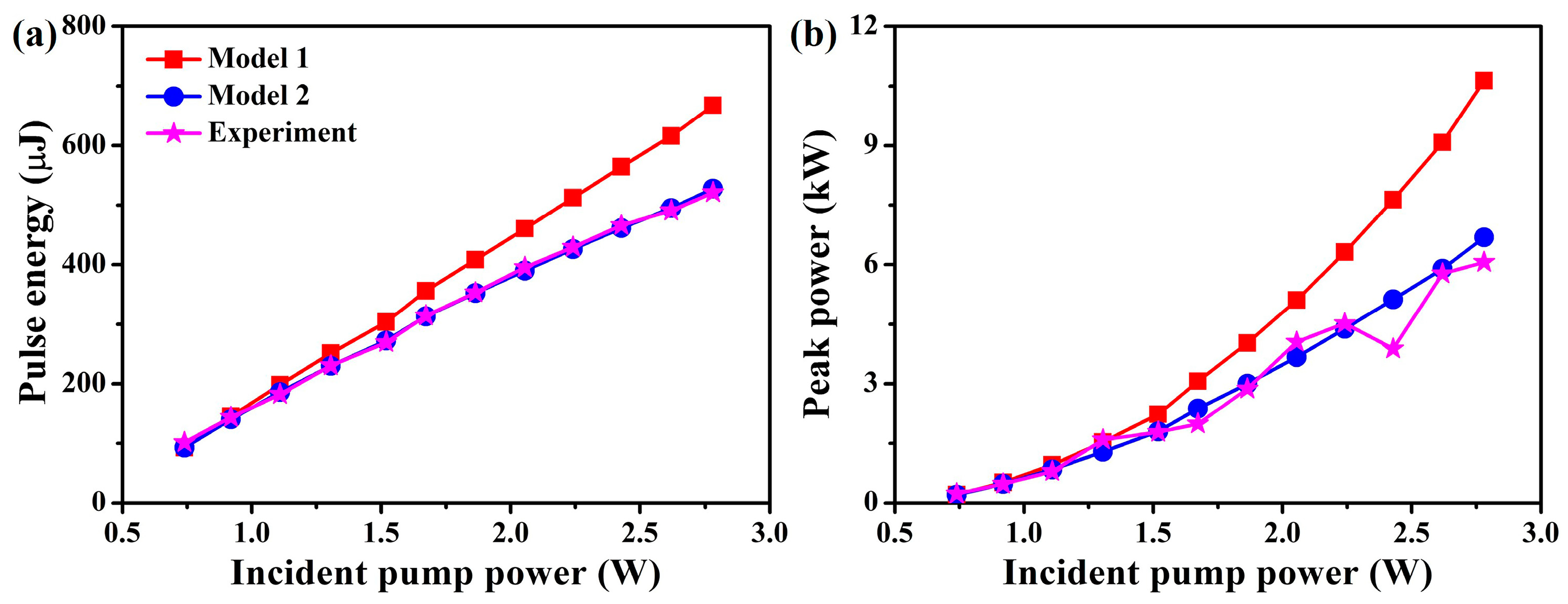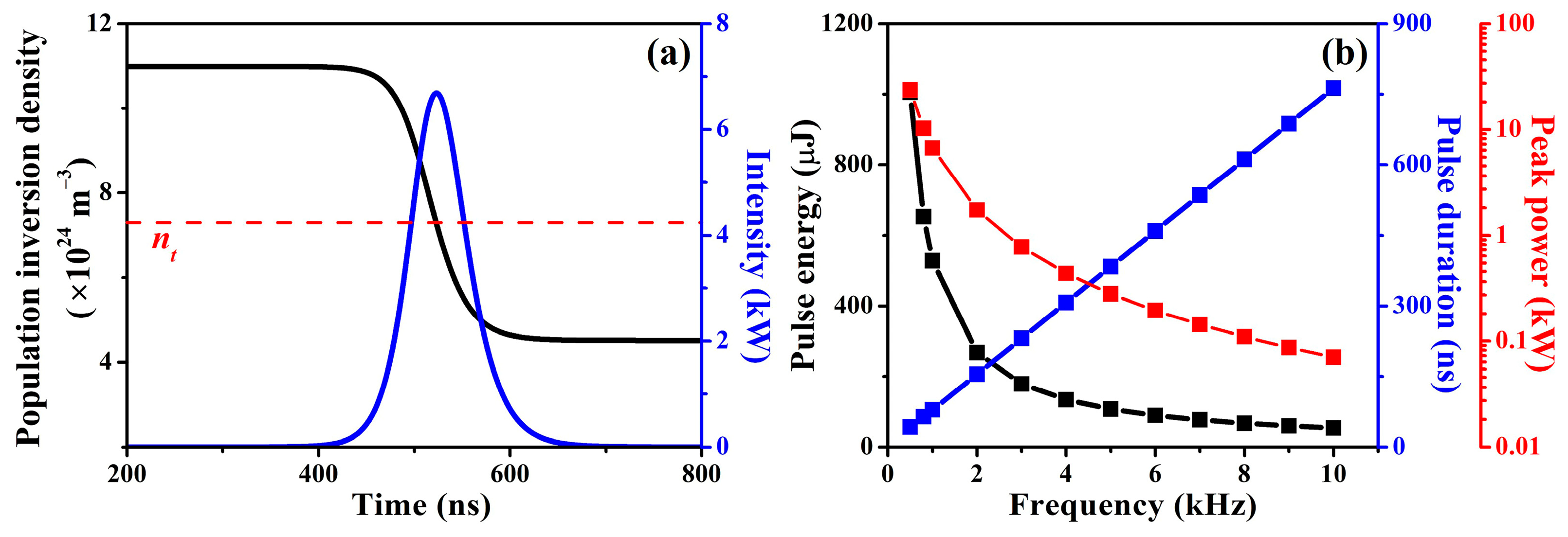A High-Peak-Power Mechanically Q-Switched Tb:LiYF4 Laser in the Green Spectral Region
Abstract
1. Introduction
2. The Experimental Setup
3. Results and Discussion
4. Conclusions
Author Contributions
Funding
Institutional Review Board Statement
Informed Consent Statement
Data Availability Statement
Conflicts of Interest
References
- Prasad, H.S.; Brueckner, F.; Volpp, J.; Kaplan, A.F. Laser metal deposition of copper on diverse metals using green laser sources. Int. J. Adv. Manuf. Technol. 2020, 107, 1559–1568. [Google Scholar] [CrossRef]
- Bovatsek, J.; Tamhankar, A.; Patel, R.S.; Bulgakova, N.M.; Bonse, J. Thin film removal mechanisms in ns-laser processing of photovoltaic materials. Thin Solid Films 2010, 518, 2897–2904. [Google Scholar] [CrossRef]
- Azadgoli, B.; Baker, R.Y. Laser applications in surgery. Ann. Transl. Med. 2016, 4, 452. [Google Scholar] [CrossRef] [PubMed]
- Mainster, M.A. Wavelength selection in macular photocoagulation: Tissue optics, thermal effects, and laser systems. Ophthalmology 1986, 93, 952–958. [Google Scholar] [CrossRef]
- Xu, J.; Kong, M.; Lin, A.; Song, Y.; Han, J.; Xu, Z.; Wu, B.; Gao, S.; Deng, N. Directly modulated green-light diode-pumped solid-state laser for underwater wireless optical communication. Opt. Lett. 2017, 42, 1664–1667. [Google Scholar] [CrossRef]
- Han, J.; Luo, T.; Sun, L.; Ding, C.; Xia, M.; Yang, K. Research of application of high-repetition-rate green laser in underwater imaging system. Proc. SPIE 2013, 8905, 89051Y. [Google Scholar] [CrossRef]
- Liu, A.; Norsen, M.A.; Mead, R.D. 60-W green output by frequency doubling of a polarized Yb-doped fiber laser. Opt. Lett. 2005, 30, 67–69. [Google Scholar] [CrossRef] [PubMed]
- Kränkel, C.; Marzahl, D.T.; Moglia, F.; Huber, G.; Metz, P.W. Out of the blue: Semiconductor laser pumped visible rare-earth doped lasers. Laser Photonics Rev. 2016, 10, 548–568. [Google Scholar] [CrossRef]
- Tanaka, H.; Kalusniak, S.; Badtke, M.; Demesh, M.; Kuleshov, N.V.; Kannari, F.; Kränkel, C. Visible solid-state lasers based on Pr3+ and Tb3+. Prog. Quant. Electron. 2022, 84, 100411. [Google Scholar] [CrossRef]
- Ostroumov, V.; Seelert, W. 1 W of 261 nm cw generation in a Pr3+:LiYF4 laser pumped by an optically pumped semiconductor laser at 479 nm. Proc. SPIE 2008, 6871, 68711K. [Google Scholar] [CrossRef]
- Chen, H.; Yao, W.; Uehara, H.; Yasuhara, R. Graphene Q-switched Tb:LiYF4 green laser. Opt. Lett. 2020, 45, 2596–2599. [Google Scholar] [CrossRef]
- Metz, P.W.; Marzahl, D.T.; Majid, A.; Kränkel, C.; Huber, G. Efficient continuous wave laser operation of Tb3+-doped fluoride crystals in the green and yellow spectral regions. Laser Photonics Rev. 2016, 10, 335–344. [Google Scholar] [CrossRef]
- Chen, H.; Uehara, H.; Yasuhara, R. Compact deep ultraviolet frequency-doubled Tb:LiYF4 lasers at 272 nm. Opt. Lett. 2020, 45, 5558–5561. [Google Scholar] [CrossRef]
- Tanaka, H.; Kalusniak, S.; Castellano-Hernández, E.; Kränkel, C. UV-pumping and passive Q-switching of visible Tb:LiLuF4 lasers. Proc. SPIE 2021, 11664, 116640G. [Google Scholar] [CrossRef]
- Chen, H.; Yao, W.; Uehara, H.; Yasuhara, R. Actively Q-switched Tb:LiYF4 green lasers. Appl. Phys. Express 2021, 14, 062002. [Google Scholar] [CrossRef]
- Yang, H.; Chen, H.; Li, E.; Uehara, H.; Yasuhara, R. Electro-optically Q-switched operation of a high-peak-power Tb:LiYF4 green laser. Opt. Express 2021, 29, 31706–31713. [Google Scholar] [CrossRef]
- Scheps, R.; Myers, J.F. Performance of a diode-pumped laser repetitively Q-switched with a mechanical shutter. Appl. Opt. 1994, 33, 969–978. [Google Scholar] [CrossRef]
- Xu, F.; Pan, Q.; Zhang, Y.; Zhang, R.; Chen, Y.; Yu, D.; Chen, F. Pulse high energy Fe: ZnSe laser pumped by Q-switched Er: YAG laser. Opt. Express 2023, 31, 26807–26814. [Google Scholar] [CrossRef] [PubMed]
- Shen, Y.; Wang, Y.; Luan, K.; Chen, H.; Tao, M.; Si, J. High peak power actively Q-switched mid-infrared fiber lasers at 3 μm. Appl. Phys. B 2017, 123, 105. [Google Scholar] [CrossRef]
- Murphy, F.J.; Arbabzadah, E.A.; Bak, A.O.; Amrania, H.; Damzen, M.J.; Phillips, C.C. Optical chopper Q-switching for flashlamp-pumped Er,Cr:YSGG lasers. Laser Phys. Lett. 2015, 12, 045802. [Google Scholar] [CrossRef]
- Karki, K.; Fedorov, V.; Martyshkin, D.; Mirov, S. High energy (0.8 J) mechanically Q-switched 2.94 μm Er:YAG laser. Opt. Express 2021, 29, 4287–4295. [Google Scholar] [CrossRef] [PubMed]
- Uehara, H.; Tsunai, T.; Han, B.Y.; Goya, K.; Yasuhara, R.; Potemkin, F.; Kawanaka, J.; Tokita, S. 40 kHz, 20 ns acousto-optically Q-switched 4 μm Fe:ZnSe laser pumped by a fluoride fiber laser. Opt. Lett. 2020, 45, 2788–2791. [Google Scholar] [CrossRef] [PubMed]
- Degnan, J.J. Theory of the optimally coupled Q-switched laser. IEEE J. Quantum Electron. 1989, 25, 214–220. [Google Scholar] [CrossRef]
- Yamashita, T.; Ohishi, Y. Amplification and lasing characteristics of Tb3+-doped fluoride fiber in the 0.54 µm band. Jpn. J. Appl. Phys. 2007, 46, L991–L993. [Google Scholar] [CrossRef]
- Liu, J.; Wang, C.; Du, C.; Zhu, L.; Zhang, H.; Meng, X.; Wang, J.; Shao, Z.; Jiang, M. High-power actively Q-switched Nd:GdVO4 laser end-pumped by a fiber-coupled diode-laser array. Opt. Commun. 2001, 188, 155–162. [Google Scholar] [CrossRef]
- Krausz, F.; Wintner, E.; Schmidt, A.J.; Dienes, A. Continuous wave thin plate Nd:glass laser. IEEE J. Quantum Electron. 1990, 26, 158–168. [Google Scholar] [CrossRef]
- Bezotosnyi, V.V.; Cheshev, E.A.; Gorbunkov, M.V.; Koromyslov, A.L.; Kostryukov, P.V.; Krivonos, M.S.; Popov, Y.M.; Tunkin, V.G. Behavior of threshold pump power of diode end-pumped solid-state lasers in critical cavity configurations. Laser Phys. Lett. 2015, 12, 025001. [Google Scholar] [CrossRef]





Disclaimer/Publisher’s Note: The statements, opinions and data contained in all publications are solely those of the individual author(s) and contributor(s) and not of MDPI and/or the editor(s). MDPI and/or the editor(s) disclaim responsibility for any injury to people or property resulting from any ideas, methods, instructions or products referred to in the content. |
© 2025 by the authors. Licensee MDPI, Basel, Switzerland. This article is an open access article distributed under the terms and conditions of the Creative Commons Attribution (CC BY) license (https://creativecommons.org/licenses/by/4.0/).
Share and Cite
Yu, L.; Yang, H.; Uehara, H.; Yasuhara, R. A High-Peak-Power Mechanically Q-Switched Tb:LiYF4 Laser in the Green Spectral Region. Photonics 2025, 12, 58. https://doi.org/10.3390/photonics12010058
Yu L, Yang H, Uehara H, Yasuhara R. A High-Peak-Power Mechanically Q-Switched Tb:LiYF4 Laser in the Green Spectral Region. Photonics. 2025; 12(1):58. https://doi.org/10.3390/photonics12010058
Chicago/Turabian StyleYu, Linpeng, Haotian Yang, Hiyori Uehara, and Ryo Yasuhara. 2025. "A High-Peak-Power Mechanically Q-Switched Tb:LiYF4 Laser in the Green Spectral Region" Photonics 12, no. 1: 58. https://doi.org/10.3390/photonics12010058
APA StyleYu, L., Yang, H., Uehara, H., & Yasuhara, R. (2025). A High-Peak-Power Mechanically Q-Switched Tb:LiYF4 Laser in the Green Spectral Region. Photonics, 12(1), 58. https://doi.org/10.3390/photonics12010058



